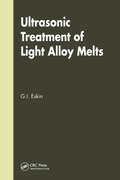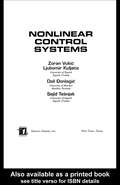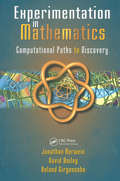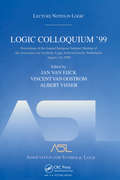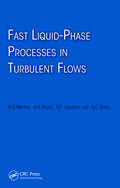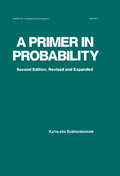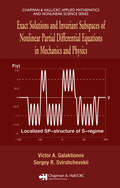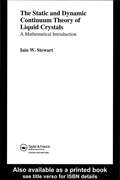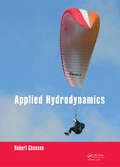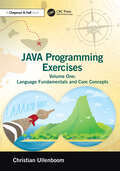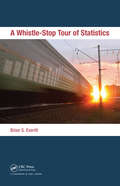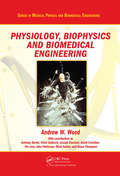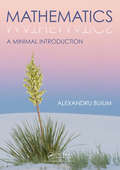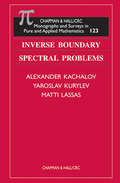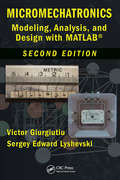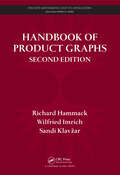- Table View
- List View
Ultrasonic Treatment of Light Alloy Melts
by G I EskinThis is the first monograph to comprehensively cover the effect of using power ultrasound to refine and solidify aluminium and magnesium alloys. The author is widely regarded as a pioneer in the field, and the text is based on results obtained over the 40 years he has spent developing these techniques. Ultrasonic treatment efficiently removes h
Practical Applications of Microresonators in Optics and Photonics (Optical Science and Engineering)
by Andrey B. MatskoAssembling an international team of experts, this book reports on the progress in the rapidly growing field of monolithic micro- and nanoresonators. The book opens with a chapter on photonic crystal-based resonators (nanocavities). It goes on to describe resonators in which the closed trajectories of light are supported by any variety of total internal reflection in curved and polygonal transparent dielectric structures. The book also covers distributed feedback microresonators for slow light, controllable dispersion, and enhanced nonlinearity. A portion of coverage is dedicated to the unique properties of resonators, which are extremely efficient tools when conducting multiple applications.
Nonlinear Control Systems (Automation and Control Engineering)
by Zoran VukicThis text emphasizes classical methods and presents essential analytical tools and strategies for the construction and development of improved design methods in nonlinear control. It offers engineering procedures for the frequency domain, as well as solved examples for clear understanding of control applications in the industrial, electrical, process, manufacturing, and automotive industries. The authors discuss properties of nonlinear systems, stability, linearization methods, operating modes and dynamic analysis methods, phase trajectories in dynamic analysis of nonlinear systems, and harmonic linearization in dynamic analysis of nonlinear control systems operating in stabilization mode.
Experimentation in Mathematics: Computational Paths to Discovery
by Roland Girgensohn Jonathan M. Borwein David H. BaileyNew mathematical insights and rigorous results are often gained through extensive experimentation using numerical examples or graphical images and analyzing them. Today computer experiments are an integral part of doing mathematics. This allows for a more systematic approach to conducting and replicating experiments. The authors address the role of
Logic Colloquium '99: Lecture Notes in Logic 17
by Jan Van Eijck Vincent Van Oostrom Albert VisserA compilation of papers presented at the 1999 European Summer Meeting of the Association for Symbolic Logic, Logic Colloquium '99 includes surveys and research articles from some of the world's preeminent logicians. Two long articles are based on tutorials given at the meeting and present accessible expositions of current research in two active are
Polymer Viscoelasticity: Stress and Strain in Practice (Plastics Engineering)
by Evaristo RiandeShowcasing vital engineering applications to transient and dynamic pertubations of macromolecular materials, structural recovery's role in mechanical responses in the glassy state, and viscoelastic parameters that condition the non-Newtonian behaviour of polymers, this work presents a systematic account of the responses of macromolecular materials
Advanced Thermodynamics Engineering (Applied and Computational Mechanics)
by Kalyan Annamalai Ishwar K. Puri Milind A. JogAdvanced Thermodynamics Engineering, Second Edition is designed for readers who need to understand and apply the engineering physics of thermodynamic concepts. It employs a self-teaching format that reinforces presentation of critical concepts, mathematical relationships, and equations with concrete physical examples and explanations of application
Fast Liquid-Phase Processes in Turbulent Flows
by Gennady Zaikov Karl Minsker Alexander Berlin Vadim ZakharovThis book deals with the fundamental laws of passing of fast liquid-phase chemical as well as heat and mass transfer processes in turbulent flows. The fundamental laws of passing of fast liquid-phase chemical and also heat and mass transfer processes in turbulent flows are considered in the book. Development of a macrokinetics approach is generaliz
A Primer in Probability (Statistics: A Series of Textbooks and Monographs)
by Kathleen SubrahmaniamSomewhat revised/expanded new edition of a problem-oriented introductory undergraduate text, the first edition of which appeared about a decade ago. The author writes with courteous clarity, and imposes only modest demands upon the mathematical skills of her readers. Problems at the end of each of t
Exact Solutions and Invariant Subspaces of Nonlinear Partial Differential Equations in Mechanics and Physics
by Victor A. Galaktionov Sergey R. SvirshchevskiiExact Solutions and Invariant Subspaces of Nonlinear Partial Differential Equations in Mechanics and Physics is the first book to provide a systematic construction of exact solutions via linear invariant subspaces for nonlinear differential operators. Acting as a guide to nonlinear evolution equations and models from physics and mechanics, the book
Acoustics of Nanodispersed Magnetic Fluids
by V. PoluninAcoustics of Nanodispersed Magnetic Fluids presents key information on the acoustic properties of magnetic fluids. The book is based on research carried out by the author as well as on many publications in both the Russian and foreign scientific literature from 1969 onwards.It describes a wide variety of topics, which together lay the foundation of
Advances In Laser Physics (Laser Science and Technology)
by V. S. Letokhov P. MeystreThe birth of quantum electronics in the middle of the 20th century and the subsquent discovery of the laser led to new trends in physics and a number of photonic technolgies. This volume is dedicated to Peter Franken, a pioneer of nonlinear optics, and includes papers by the founders of quantum electronics, Aleksandr Prokhorov, Nicolaas Blombergen,
The Static and Dynamic Continuum Theory of Liquid Crystals: A Mathematical Introduction (Liquid Crystals Book Series)
by Iain W. StewartGiven the widespread interest in macroscopic phenomena in liquid crystals, stemming from their applications in displays and devices. The need has arisen for a rigorous yet accessible text suitable for graduate students, whatever their scientific background. This book satisfies that need.The approach taken in this text, is to introduce the basic continuum theory for nematic liquid crystals in equilibria, then it proceeds to simple application of this theory- in particular, there is a discussion of electrical and magnetic field effects which give rise to Freedericksz transitions, which are important in devices. This is followed by an account of dynamic theory and elementary viscometry of nemantics Discussions of backflow and flow-induced instabilities are also included. Smetic theory is also briefly introduced and summarised with some examples of equilibrium solutions as well as those with dynamic effects. A number of mathematical techniques, such as Cartesian tensors and some variational calculus, are presented in the appendices.
Applied Hydrodynamics: An Introduction
by Hubert ChansonThis textbook treats Hydro- and Fluid Dynamics, the engineering science dealing with forces and energies generated by fluids in motion, playing a vital role in everyday life. Practical examples include the flow motion in the kitchen sink, the exhaust fan above the stove, and the air conditioning system in our home. When driving a car, the air flow
Java Programming Exercises: Volume One: Language Fundamentals and Core Concepts
by Christian UllenboomTake the first step in raising your coding skills to the next level, and test your Java knowledge on tricky programming tasks, with the help of the pirate Captain CiaoCiao. This is the first of two volumes which provide you with everything you need to excel in your Java journey, including tricks that you should know in detail as a professional, as well as intensive training for clean code and thoughtful design that carries even complex software.Features: About 200 tasks with commented solutions on different levels For all paradigms: object-oriented, imperative, and functional Clean code, reading foreign code, and object-oriented modeling With numerous best practices and extensively commented solutions to the tasks, these books provide the perfect workout for professional software development with Java.
A Whistle-Stop Tour of Statistics
by Brian EverittThe book is intended as a quick source of reference and as an aide-memoir for students taking A-level, undergraduate or postgraduate statistics courses. It includes numerous examples, helping instructors on such courses by providing their students with small data sets with which to work.
Image Analysis: Methods and Applications, Second Edition
by Donat-P. HaderAutomatic image analysis has become an important tool in many fields of biology, medicine, and other sciences. Since the first edition of Image Analysis: Methods and Applications, the development of both software and hardware technology has undergone quantum leaps. For example, specific mathematical filters have been developed for quality enhanceme
Soft Condensed Matter Physics in Molecular and Cell Biology
by W C K Poon D AndelmanSoft condensed matter physics, which emerged as a distinct branch of physics in the 1990s, studies complex fluids: liquids in which structures with length scale between the molecular and the macroscopic exist. Polymers, liquid crystals, surfactant solutions, and colloids fall into this category. Physicists deal with properties of soft matter system
Physiology, Biophysics, and Biomedical Engineering (Series in Medical Physics and Biomedical Engineering)
by Andrew W. WoodPhysiology, Biophysics and Biomedical Engineering provides a multidisciplinary understanding of biological phenomena and the instrumentation for monitoring these phenomena. It covers the physical phenomena of electricity, pressure, and flow along with the adaptation of the physics of the phenomena to the special conditions and constraints of biolog
Mathematics: A Minimal Introduction
by Alexandru BuiumBridging the gap between procedural mathematics that emphasizes calculations and conceptual mathematics that focuses on ideas, Mathematics: A Minimal Introduction presents an undergraduate-level introduction to pure mathematics and basic concepts of logic. The author builds logic and mathematics from scratch using essentially no background except n
Hplc Of Biological Macro- Molecules, Revised And Expanded
by Karen M. Gooding Fred E. RegnierCompletely revised to reflect the innovations in HPLC from the past decade, this authoritative reference presents practical strategies for the evaluation and analysis of proteins, peptides, and polynucleotides. Offering class-specific applications for the characterization and fractionation of biological macromolecules, the book contains material on organic supports, size exclusion, ion exchange, hydrophobic interaction, and metal interaction chromatography. Leading experts summarize specialized detection systems, provides discussions on the chemical and biological properties of specific biomolecules, include detailed guidelines for the development of analytical techniques, and more.
Inverse Boundary Spectral Problems (Monographs and Surveys in Pure and Applied Mathematics)
by Alexander Kachalov Yaroslav Kurylev Matti LassasInverse boundary problems are a rapidly developing area of applied mathematics with applications throughout physics and the engineering sciences. However, the mathematical theory of inverse problems remains incomplete and needs further development to aid in the solution of many important practical problems.Inverse Boundary Spectral Problems
Micromechatronics: Modeling, Analysis, and Design with MATLAB, Second Edition (Nano- and Microscience, Engineering, Technology and Medicine)
by Victor Giurgiutiu Sergey Edward LyshevskiFocusing on recent developments in engineering science, enabling hardware, advanced technologies, and software, Micromechatronics: Modeling, Analysis, and Design with MATLAB, Second Edition provides clear, comprehensive coverage of mechatronic and electromechanical systems. It applies cornerstone fundamentals to the design of electromechanical syst
Mathematical Principles of Remote Sensing: Making Inferences from Noisy Data
by Andrew S MilmanThis book is an informative reference, or working textbook, on the mathematics, and general physical and chemical processes behind remote sensor measurements.
Handbook of Product Graphs (Discrete Mathematics and Its Applications)
by Richard Hammack Wilfried Imrich Sandi KlavžarThis handbook examines the dichotomy between the structure of products and their subgraphs. It also features the design of efficient algorithms that recognize products and their subgraphs and explores the relationship between graph parameters of the product and factors. Extensively revised and expanded, this second edition presents full proofs of many important results as well as up-to-date research and conjectures. It illustrates applications of graph products in several areas and contains well over 300 exercises. Supplementary material is available on the book's website.
